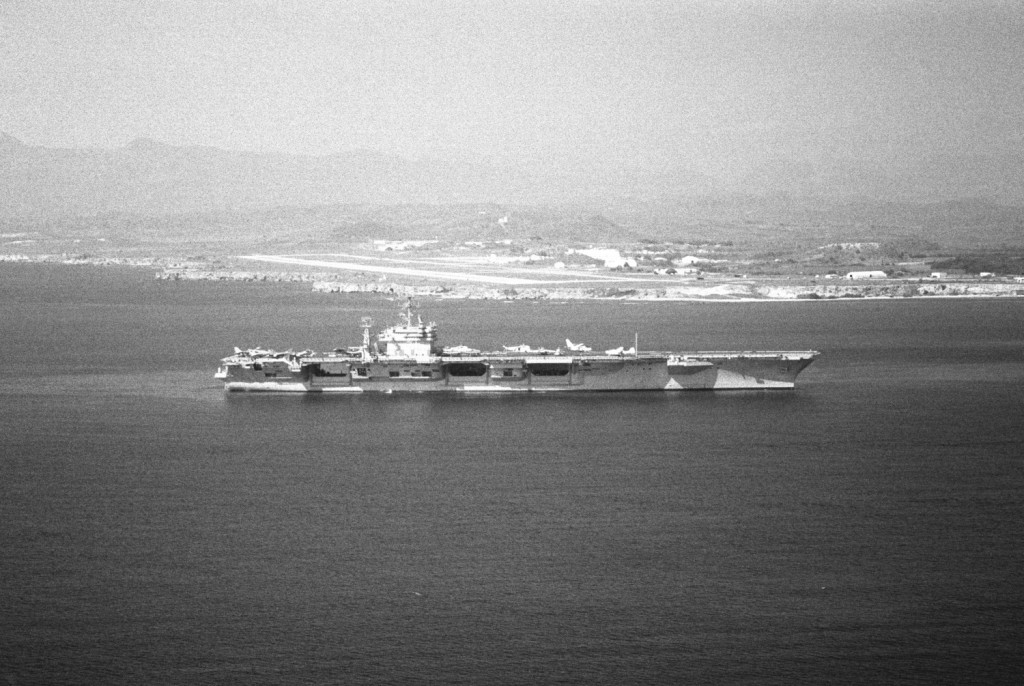Sugar and the Economics of Empire
National Dialogue and Traveling Exhibit

A starboard beam view of the nuclear-powered aircraft carrier USS THEODORE ROOSEVELT (CVN 71) anchored in Guantánamo Bay.
The current focus on Guantánamo as a symbol of American military power makes the relationship between the base and its surroundings mostly political. The early history of Guantánamo Bay, however, demonstrates the role of American economic power in military actions. In the early 20th century, the American move to Cuba was not solely military. The fertile land drew investors interested in sugar. This pattern has been categorized as a wing of military occupation and another of investors, bringing capital in exchange for land.
The eastern part of Cuba, including Guantánamo, had long been the land of refugees. Small landowners originally owned much of the fertile land where they grew coffee and cacao. The immigration of sugar production set off a consolidation of land ownership in the land around Guantánamo. Foreign ownership was rampant in Cuba by 1906: they owned an estimated 60 percent of rural land, with the Americans owning 15 percent. According to Jonathan M. Hansen, Americans were drawn to Cuban money, not their political system.
The United States remained willing to intervene in Cuban affairs in order to stabilize the political system in order to protect business interests on the island. Guantánamo served as a launching point for U.S. Marines in multiple campaigns to suppress uprisings to protect American property and settlers. One notable example is the “race war” in 1912. During this uprising the Partido Independiente de Color (PIC), a group of Afro Cubans who left the Liberal Party, set about destroying American property throughout Cuba, with the most damage in the Oriente Province.
As it had during the rebellions in 1906, the destruction of American property in Cuba got the attention of the American military. In four days in late May 1912 over 2,000 enlisted men and 69 officers arrived on nine battleships. American commanders expressed confusion on the nature of the uprising, but they were sure about their mission—to protect American property. The U.S. ambassador to Cuba, A.M. Beaupré, argued that the Cuban government understood the difference between American intervention in national politics and the presence of U.S. Marines on Cuban soil to protect American property. Small detachments were sent to the eastern cities to suppress the rebellion. Starting in July, Marines were withdrawn from Cuban soil and brought back to the U.S. base at Guantánamo.
The role of the US military as protectors of American property during revolutions in Cuba illuminates an under-reported aspect of Guantánamo’s history. Protecting American economic interests was considered the only valid reason to use Marines to stabilize the countryside. The connection between the military action and the nation’s economic imperatives is often connected with modern conflicts as well—most famously, the condemnation of the Iraq War as an errand for oil. The history of intervention at Guantánamo reveals the long history of overlap between U.S. military actions and local economic interests. The history of Guantánamo and its position in the early American empire reveals that economic interest was closely related to military and political power. Understanding the multi-pronged nature of the American expansion into the Caribbean provides a more complex way of looking at the American empire and the continual relationship between economics and displays of global power.
Posted by Andrea Field—PhD students at Arizona State University
Arizona State University is participating in the Guantánamo Public Memory Project‘s National Dialogue and Traveling Exhibit. Opening at NYU’s Kimmel Center for University Life Windows Gallery in December 2012 and traveling to 9 sites (and counting) across the country through at least 2014, the exhibit will explore GTMO’s history from US occupation in 1898 to today’s debates and visions for its future. The exhibit is being developed through a unique collaboration among a growing number of universities as a dialogue among their students, communities, and people with first-hand experience at GTMO.
